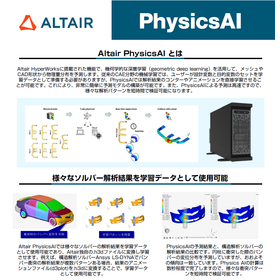Frequency response analysis software for dynamic magnetic fields using the finite element method EDDY jω
Perform frequency response analysis Finite element method magnetic field analysis software (magnetic field simulator) ■□■Features■□■ ■Since it is integrated with the PHOTO series dedicated pre-post, data creation, analysis, and result processing can be performed as a series of operations. ■It is integrated with other PHOTO series modules, allowing for easy coupled analysis, such as obtaining temperature distribution from heat generation determined by electromagnetic field analysis. ■A revolutionary speedup has been achieved through the combined use of edge element method and ICCG method (dozens of times faster than conventional finite element methods). ■When a sine wave input is used and linear approximation holds, results can be obtained in a single calculation without the need for time-stepping calculations. ■Since it uses the finite element method, the solutions are stable, making it safe for beginners to use. ■Coupled calculations with thermal conduction analysis, stress analysis, and fluid analysis are easy.
Inquire About This Product
basic information
The software for magnetic field analysis using the finite element method performs frequency response analysis. ■ It can handle three-dimensional, two-dimensional, and axisymmetric problems. ■ Linear, nonlinear, and anisotropic permeability can be considered. ■ Analysis considering linear and nonlinear electrical conductivity is possible. ■ The temperature dependence of permeability and electrical conductivity can be taken into account (3D). ■ It allows input of currents with multiple phases. ■ There is an automatic current input function and a voltage input function (3D). ■ Analysis considering eddy currents generated in conductors within a varying magnetic field can be performed. ■ It can handle moving objects relative to each other through a slide interface. ■ As analysis results, magnetic flux density, eddy current distribution, etc., can be obtained as real and imaginary components. Additionally, the Lorentz force is output. ■ Using the permeability from files obtained from nonlinear magnetic field analysis by PHOTO-EDDY, analysis considering the nonlinearity of magnetization characteristics can be performed. ■ The types of output analysis results can be controlled. ■ The influence of the skin effect of primary side current can be considered. ■ For other functions and details, please download the catalog or contact us.
Price information
-
Delivery Time
Applications/Examples of results
■□■Applicable Fields■□■ ■Fields where simulation of phenomena involving eddy currents is necessary ■Linear motors, magnetic heads, non-destructive testing (eddy current testing), induction heating, free electron lasers, induction machines, RFID-related applications, etc.
catalog(1)
Download All CatalogsCompany information
At Photon, we are developing "electromagnetic field analysis software" that models and simulates products and components utilizing electromagnetic phenomena on a computer. In traditional design and development environments, the process has primarily revolved around trial and error through prototyping based on the experience of engineers and experiments with prototypes. However, conducting experiments using actual prototypes and analyzing the results requires significant time and cost. Moving forward, transitioning from an experimental and prototyping-based approach to an analysis-based design approach will be a crucial challenge for improving productivity, and establishing simulation technology as the core of analysis-based design techniques will be essential. In this context, Photon is developing and providing "analysis software" focusing on electromagnetic fields, as well as heat, vibration, and sound fields. By utilizing Photon's software, efficient development and design of various industrial products can be achieved. In this way, Photon aims to support users in reducing the number of prototypes, lowering development costs, and shortening development periods in their manufacturing environments, ultimately enhancing their competitiveness.







![[Analysis Case] Magnetic Field Analysis of Gear Sensors](https://image.mono.ipros.com/public/product/image/962/2000763847/IPROS58205498186159764360.png?w=280&h=280)




![SOLIDWORKS 2026 New Features Seminar [Free Participation]](https://image.mono.ipros.com/public/default/object/noimage_l.gif?w=280&h=280)